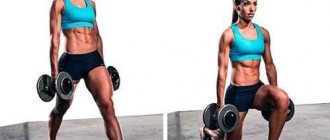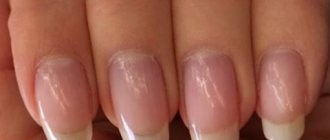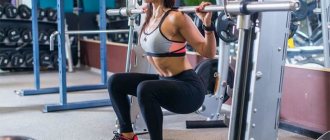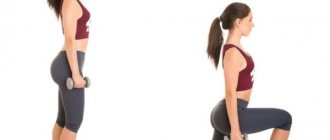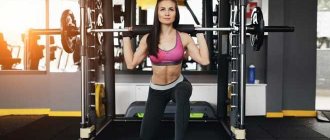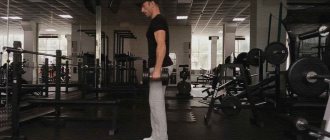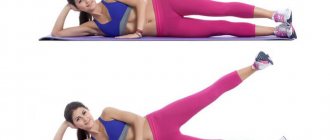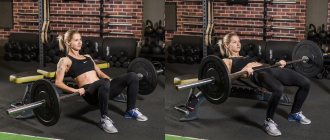Beautiful and attractive buttocks are the dream of every girl. To get them, you need to train hard and purposefully. Including performing special exercises to pump them up. One of these is curtsy lunges.
Quite an unusual name, don't you agree? Analogies immediately appear - this is something from dancing. But, no, this is a very effective exercise for shaping the gluteal muscles. Let's try to consider in detail what it is, who it is recommended for and how to do it correctly.
Note that curtsey lunges are not an exercise for beginners who have just come to the gym. They are recommended to be performed only after mastering the squat technique.
Cross lunges are so named because when performing the exercise you have to cross your legs at the bottom of the movement, due to which the glutes receive maximum load and a good stretch.
You can perform the exercise with any equipment you like - a barbell, dumbbells, weights, or not use weights at all. Although the latter option is better done to practice the technique. After all, achieving muscle fiber hypertrophy without weight is not an easy task.
Diagonal lunges are one of the favorite exercises for fitness athletes who want to demonstrate the ideal proportions of their lower body in competitions. After all, with their help you can make your buttocks more expressive. Therefore, it is worth taking note of the exercise and including it in your training program.
What muscles are trained by curtsey lunges?
Like any lunge, first of all, the gluteal muscles and quadriceps of the thigh are subjected to greater load In addition to the external muscles (gluteus maximus and gluteus medius), the exercise works the gluteus minimus muscles, since the muscle is internal, it will add additional roundness and volume to the buttocks, which cannot be obtained by training only the external group. The shape of the buttocks becomes more “raised” at the top. Additionally, the work includes the hamstrings and adductor muscles of the thigh. To stabilize the spine, the abdominal and lower back muscles are also involved.
Typical mistakes and contraindications
You should not take on additional weights if you have not yet mastered the cross lunge movement technique.
Improper execution of the exercise and unprepared ligaments and joints more often result in injury than actual results in muscle growth.
Like most lunge variations, the curtsy has a number of contraindications:
- This movement is not suitable for people with spinal problems. Twisting in the lumbar region during a step places stress on the lumbar region, which can aggravate existing problems.
- Injuries and diseases of the joints - hip, knee, ankle. As well as injuries and sprains of muscles and ligaments involved in movement
- Curtsy lunges should be used with caution if you have heart problems or hypertensive patients. Lunges put a lot of stress on the heart and blood vessels. For beginners with such features, such a load is often unbearable
- Weak vestibular system and coordination
These indicators can be trained, but in the first lessons, the exercise can cause dizziness and weakness in such students.
Features of the curtsy exercise
The peculiarity of the technique of performing cross lunges, performed like a dance “curtsey,” is the additional stretching of the gluteal group. The more a muscle is stretched, the better it grows, since in addition to its contraction, the stretching phase gives the muscle the opportunity to quickly restore its correct (physiological) shape. This is what happens in the lower phase of the lunge, when the supporting (front) leg experiences a greater stretch in the buttocks due to the oblique lunge (criss-cross).
Pros of exercise
- Forms the gluteus maximus muscles, works the deep muscles (gluteus minimus), making the shape feminine and round.
- In addition to contraction, it stretches the muscles, preventing them from becoming stronger in the future.
- Improves coordination of movements, activates stabilizer muscles.
- Tones the outer and adductor surfaces of the thighs, tightening the leg muscles and removes fat deposits of the “breeches” type.
- Fights fatty tissue throughout the body, removing volumes evenly.
- Removes excess fluid, relieving swelling in the legs, improves skin texture.
Disadvantages of curtsey squats
- The technique requires good coordination and stability of the pelvis during a cross lunge, and is difficult for beginners.
- Any problems with the hip, knee, or ankle joints are a contraindication to performing the exercise, since during a cross lunge the joints are displaced, which can cause pain.
- The technique is recommended to be performed only by healthy and flexible people, without disrupting the functioning of the cardiovascular system.
Features of the technique
Cross lunges are a difficult coordination movement. This imposes its own specifics on the technique of performing the exercise:
- Be sure to do a pre-warm-up
Curtsy lunges involve a large number of muscles, ligaments and joints. If they are not warmed up, then the likelihood of injury during execution increases.
Particular attention is paid to warming up the knee, hip, and ankle joints and ligaments.
- It is better to place the exercise in the middle of the leg complex.
By this point, the muscles are already sufficiently warmed up, and the ligaments and joints are more elastic from performing previous exercises. Such a small nuance will increase the effectiveness of diagonal lunges and protect against injury.
- Complicate the exercise in several ways
For example, placing a step platform under your front leg, or putting weights on your ankles.
Another option is to hold dumbbells in your hands or place a small barbell on your shoulders.
- To engage your glutes more, take a wide step back. This will require good flexibility in the joints of the legs and elastic muscles and ligaments.
Before you begin, make sure that your sports shoes will not slip on the floor. This will protect you from injury.
In the gym, such exercises are usually done on a special rubber surface.
Technique for performing curtsy lunges
- Place your feet close to each other, palms on your waist.
- Leave your right leg in place, and while inhaling, lunge (step) your left leg back slightly diagonally onto your toes, thus crossing your legs.
- The knee of the back leg does not touch the floor, and the front knee remains at a right angle.
- Feel the stretch in your buttocks; if necessary, move your foot a little more diagonally.
- Exhale and push off with the heel of your supporting foot and return your left leg to the starting point. It is important to feel not only the quadriceps, but also the gluteal muscle when lifting.
- Repeat as many times as necessary on your right leg, then switch sides.
An important feature of the technique: the pelvis does not rotate in the direction of the lunge; keep it stable, without rotating the hip joint and body.
Execution technique
Let's look at cross-legged lunges, or so-called curtsy squats, in more detail.
So, stand up straight, place your feet slightly wider than your shoulders and point your toes slightly apart. Your knees should be pointing in the same direction as your toes. A serious mistake would be to curl the knees during a squat, i.e., if the foot is pointing outward, the knee is turned outward, if inward, then inward.
- Shift your weight to one leg and take a long step back with the other, diagonally towards your supporting leg. As a result, you have one leg in front, the toe of its foot is directed outward, the second leg is behind, crosswise, its toe is directed forward or very slightly inward (the knee is in the same direction).
- Squat down, bending the knee of your working leg so that your thigh is parallel to the floor. The knee does not go beyond the toe, and the weight remains on the heel throughout the entire movement. With the knee of your supporting leg, reach towards the floor behind your working leg, but do not touch it. At the bottom of the squat, you should feel a stretch in the gluteal muscles of your working leg.
- Rise up with your legs straight.
Next, you can either repeat squats without changing the crossed position of your legs, or return to the starting position (feet wider than shoulders) and on the next repetition take a step back with your supporting leg and squat. The second option makes the exercise more dynamic and is recommended if you are training for fat loss.
Traditionally, lunges are performed 15–20 times in each direction in 3–4 approaches. However, you can vary the load depending on your training goals.
High load level
Option No. 1: with a platform
Perform lunges while standing on a platform, lowering your feet to the floor diagonally. The platform will increase stretching of the gluteal muscles.
Option #2: Cross Lunges with Dumbbells
- Take light dumbbells in your hands.
- Lower them straight along the body.
- Perform cross lunges without bending your elbows, holding dumbbells in one position along your thighs.
Option No. 3: with a barbell
- Place a small barbell or empty bar on the top of the trapezius muscle.
- Keep your back straight without bending forward.
- Stabilize your position and tighten your back and abdominal muscles.
- Perform lunges on one leg, then change to the other.
- After this, lift the barbell above your head, lower it slowly to your chest, and straightening your elbows, lower it to the floor.
Important! When working with heavy weights, perform the exercise in a special power rack, removing the barbell from the racks and returning it back immediately after completing the exercise.
Option #4: Smith machine
- Level the bar in the machine by placing it at shoulder level.
- Place the bar on the trapeze, grasp it with your hands wider than shoulder-width apart.
- Lift the bar from the racks, turning the hands, remove the locks.
- Standing in the center, perform lunges on one side, then on the other. Do not rotate your body and pelvis.
- After completing the approach, rotate and secure the bar to the racks.
Execution options
#1. In general, a curtsey is performed in motion - that is, the girl takes a step back with one leg (lunges) - returns to the starting position and does the required number of repetitions with the other leg.
However! In my opinion, this is not suitable for beginners because it is difficult and you lose your balance.
#2. Therefore, for beginners, I offer the option of performing a static curtsey.
Statics is when the exercise is performed fixed in one place (in one position).
That is, the girl moved her leg back (lunged) and that’s it, she performed the required number of repetitions.
Regarding the above, watch the video right now from 2 minutes:
#3. The curtsey can be performed simply on the floor, for a better effect - with a stand.
With a stand, the load increases due to stretching the range of motion (the stand increases the stretching of the buttocks (the buttocks stretch more)) and the exercise becomes harder, and therefore more effective.
I recommend watching the video:
Technique for performing curtsy lunges: features and nuances
Let's try to take a closer look at how to correctly do diagonal lunges with crossed legs. The movement technique is of an average level of difficulty; there are a number of points and nuances that should be adhered to.
Otherwise, when working with weight, you can get a sprain or injury. Therefore, you should follow all the recommendations and start working without weights in order to hone your technique and increase the flexibility of your joints.
Lunge curtsy technique:
- Starting position: stand straight, place your feet slightly wider than your shoulders, and spread your toes slightly to the sides. The choice of weights is quite large, since you can use almost anything “your heart desires”. And this is not only a barbell and dumbbells, but also weights and athletic pancakes. But more about these variations below.
- While inhaling: transfer the weight to one leg, and take a wide step back with the other so that it is diagonally behind, on the side of the supporting leg. The result is a crossing of the legs. In this case, the front knee should be at a right angle (thigh parallel to the floor), and the back knee should not touch the floor. It is important to remember that, as in classic lunges, the knee of the supporting leg does not extend beyond the toe, and the knee of the working leg should be pulled towards the floor for better stretching of the target muscles.
- As you exhale: feeling the stretch in the buttocks and quadriceps at the lowest point, return the leg to the starting position by pushing the heel of the supporting leg.
